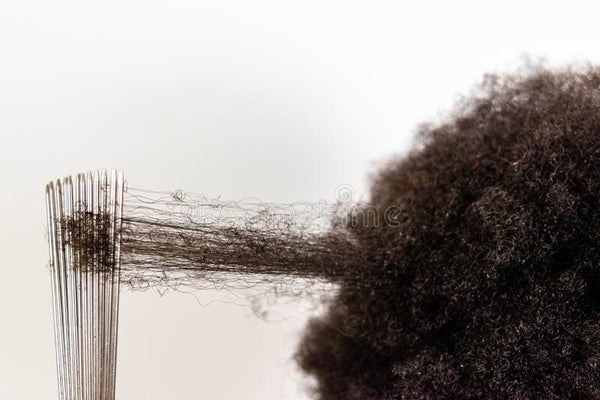How To Stop Hair Breakage: Treatment, Causes, and Ways To Prevent Your Hair From Breaking Off
- Posted on 26 January, 2019
- Hot Topic
- By Kenneth

One of the most common hair care topics that we’re asked about is hair breakage.
Your hair is primarily made up of moisture and proteins. The hair breakage that you experience is often a result of an imbalance between moisture and protein elements that make up your hair strands.
The relationship between moisture and protein within our hair strands isn’t a simple case of balancing out the two opposing forces to prevent hair breakage.
The two components work hand in hand to produce a healthier head of hair, and neither one can work on its own, as they both rely on each other. If that’s confusing, keep reading. I’ll explain in detail how to keep your hair healthy, incorporate hair breakage treatments into your hair regimen, and prevent future hair breakage.

Moisture vs Protein Balance
Moisture
Moisture, in essence, is water and not oil or any other specially formulated substances. Our hair requires water to maintain its ability to stretch or maintain elasticity.
Without moisture, your hair will feel dry and break more easily.
Considering that water is the best moisturizer, water-based hair products offer the most significant moisturizing benefits.
A moisturizer is a water-based product that nourishes your hair from deep within the strands. Products that contain moisturizing properties tend to be leave-ins, moisturizer creams, moisturizer sprays, or conditioners.
It’s also worth noting that some moisturizers may contain substantial amounts of proteins; however, protein-based moisturizers don’t provide the same moisturizing benefits that moisture-based moisturizers offer.
Make sure to read the product label to gauge the level of protein content within a moisturizer.
A good moisturizer won’t contain cheap, low-quality filler ingredients like mineral oil, lanolin oil, or petrolatum. Therefore, avoid any product that claims moisturizing benefits but includes these ingredients.
There’s nothing moisturizing in these additives. In fact, mineral oils and petrolatum are sealants, which means that they will seal out the moisture your hair so desperately needs.
Our hair loses moisture throughout the day. To maintain the moisture in your hair, we recommend sealing in the moisture with a heavier product.
Hair oils such as Jamaican black castor oil, jojoba oil, amla oil, emu oil, and rosemary oil are some of our favorites.
Most oils are made up of large molecules that are too large to be adequately absorbed by hair strands. Most oils will only coat the outer part of the hair strand, giving it shine, which is an illusion of moisture.
It is worth noting that most oil molecules are hydrophobic, meaning that they don’t easily mix with water.
Applying oils to hair strands traps moisture inside; as such, the moisture inside stays inside, and the moisture that’s outside remains outside.
Using oils without moisturizers or before applying a moisturizer will seal out moisture from the hair strand. This will coat the hair strand and eventually lead to dryness.
Achieving moisturizing success and fighting hair breakage will ultimately be determined by how you apply your hair products.
Remember, applying hair oils to your hair before you’ve added moisturizing products creates a sealing effect on your hair strands, making it hard for moisture and water to penetrate.
Protein
Protein gives the hair its structure and strength. Our hair is made up of about 70% protein, and proteins play very crucial roles and functions in hair care.
Some proteins enhance elasticity, while others, well, reduce it.
Proteins attach to hair cuticles and help rebuild, albeit temporarily, any weak areas. A protein-based hair product reinforces your hair shafts, giving them the strength to fight off breakage.
While some proteins are much stronger than others, daily or even weekly use of some of the milder protein treatments could result in moisture and protein level imbalances within hair strands for some people.
This is where the product’s composition plays a role.
For example, not every product containing keratin proteins will feel the same way as other products with similar ingredients. Similarly, not every product containing water or glycerin is going to feel the same.
For example, the protein levels in a hair product could make up 0.2% or 20% of the product.
Although, it’s hard to really tell.
So, that means that you’ll have to experience several products to see how they react to your hair.
Hair protein tolerance will most certainly vary from one product to the next product and not necessarily from protein to protein.
Proteins are commonly found in products like protein-reconstructor conditioner treatments, leave-in conditioners, some moisturizers, and instant conditioners.
Women with color-treated hair or relaxed hair will require more proteins since the processes of color-treating or relaxing hair compromises the protein structure of your hair.
Coloring or relaxing your hair will break protein bonds. The amount of protein you’ll need will also depend on the type and strength of the relaxer used and the amount of protein bond breakage you have experienced.
Plus, there are some individuals with hair that is naturally protein deficient (maybe because of low protein dietary intake or genetics), and so they need proteins more regularly than others to maintain the balance.
Whatever the case, it is vital that you experiment with your hair to get to know what it needs most.
How to Balance Moisture and Protein

Your hair’s moisture content is dependent on the amount of protein it contains. Protein loss caused by chemical treatments is almost certainly followed by a loss of moisture to some extent.
Hair that’s well proteinated will absorb moisture more efficiently since water molecules readily bind to sound protein structures within the hair.
Achieving the right balance will involve using the right combination of moisture and protein-based products that suit your hair type.
Here are some scenarios for you to consider:
Scenario #1: Keisha’s hair is breaking like crazy. It also feels wiry, dry and crunchy. Every time Keisha runs her hand through her hair, pieces of hair seem to break off.
Combing without seeing tons of little hairs covering up her sink is impossible. Keisha’s hair is always rough and hard, even if it is wet. She is tried using a couple of protein treatments because she read on the product packaging that it will stop breakage and rebuild damaged hair. But thus far, nothing has worked, and her problem only seems to get worse.
After reading this case study, I encourage you to read Keisha’s hair story. It’s one of the best hair stories I’ve ever read. Her husband’s reaction is priceless.
Scenario #2: Brittany is experiencing hair breakage. Her hair is dry, weak, and has a dull, lifeless appearance. It’s too thin even to withstand simple combing and detangling is a nightmare.
Brittany has been deep conditioning her hair regularly and doing hot oil treatments once a week. Since the breakage began, she’s started conditioning her hair more often, but the problem only seems to get worse.
Same Problem. Different Solutions.
Keisha and Brittany both have the same basic issue. They’re both experiencing hair breakage. However, the solution to their individual hair problems will require different approaches.
The two examples perfectly illustrate what ensues when the balance between moisture and protein is tipped too far in one direction.
In the section of this article, we will teach you how to effectively identify the difference between moisture-based and protein-based hair problems.
We’ll also show you how to organize your natural hair regimen to effectively mitigate these issues.
Wet Hair Assessment

Hair breakage is the result of the hair’s chemistry being thrown off balance.
Remember Keisha and Brittany? Hair that’s shifted too far to either side of the optimal balance – either too much moisture or too much protein – will eventually break.
Identifying why your hair is breaking is often easier when your hair is wet. When your hair is wet, the hair will exude the basic properties of strength and elasticity. In fact, these qualities will often be exaggerated when your hair is wet.
Comprehensive wet hair assessments will help your hair remain healthy and in great condition.
When your hair is in its optimal condition, it shouldn’t easily break when wet unless unnecessary stress is placed on it through aggressive detangling, combing, or pulling.
Well-balanced hair will have a supple, soft feel but will still be strong enough even when wet. When combing through it, it should be able to resist excessive stretching and won’t break if you’re careful.
Over time, after days of trial and error, you should be able to tell when your hair is stressed.
In the event your hair breaks when wet, how it breaks under the conditions should be a clear indication of whether more protein or moisture is needed to regain optimal moisture protein balance.
How to Perform a Wet Assessment on Your Hair

It is almost impossible to wet assess your hair by simply holding one hair strand and pulling it on both ends. This process would create ‘undue’ stress since no single strand of hair is ever truly subjected to that kind of tension at any given time.
Regardless of whether it’s healthy or not, a strand of hair pulled by both of its ends will most likely break, depending on the amount of pressure applied.
The best way to perform a wet assessment on your hair is by performing the normal act of touching it or combing through it.
A Breakdown of Wet Assessment Hair Breakage
- If when wet, your hair feels mushy, limp, gummy, or weak, consider adding more protein to your regimen.
- If when wet or dry your hair stretches a little bit and then returns to its original length without breaking, it is well balanced. Continue to use your current natural hair regimen unless you begin to notice issues.
- If when wet or dry, your hair stretches a little more than usual and then breaks, you need to add more protein to your regimen.
- If when wet or dry, your hair stretches and continues to even more stretch without breaking, then add more protein to your regimen.
- When wet or dry, your hair experiences little to no stretching at all, and breaks easily, increase the moisture in your regimen.
- When dry, if your hair feels tangly, dry, hard, brittle, rough, or a combination of any of these, then consider adding more moisture to your regimen.
- If you’re sure, we recommend starting with additional moisture regarding than starting with protein.
So you’ve figured out the type of hair breakage you have. What’s next?
Hair that’s thrown off balance by too much protein will easily break when wet or dry because it has no elasticity. Elasticity is the hair’s ability to be stretched, manipulated, and styled without breaking.
If your hair breaks with little stretching or tension, then this is a sign that there is an overabundance of proteins and very little moisture.
When your hair is in this state, any form of tension or stretching will cause your hair to break since the protein only adds structure to the hair. Excessive protein structure will only make your hair rigid, decreasing its elasticity.
This results in a brittle hair shaft that’s prone to breakage. This is the problem with Keisha’s hair. Keisha was using more protein treatments than necessary to maintain a healthy balance.
If this is a description of your hair, read carefully. To reverse this imbalance, all you need to do is implement a deep moisturizing and conditioning regimen.
Protein-induced breakage can take a couple of weeks to repair. This type of breakage will often require very intensive treatment and conditioning compared to moisture-induced breakage issues.
Protein-induced breakage along the hair shaft is one of the most common and most aggressive types of damage. It’s much easier to overload your hair with protein and cause breakage than it is to overload your hair with moisture and cause breakage.
That’s why if you aren’t sure what’s causing your hair to break, you should try and give your hair moisture initially. Depending on the level of breakage, a moisture-based regimen may need to be followed for a few weeks.
We recommend that you deep clean your hair with clarifying shampoo to remove product build-up from your hair. After clarifying, you can use a 30-to-45 minute deep conditioning treatment once or twice a week.
Apply water-based moisturizers to your hair on a daily basis (focus on the ends on the ends of your hair). Limit the use of products with “hidden” proteins like leave-in conditioners, gels, certain moisturizers, and instant conditioners.
Several commonly used hair products contain protein, so try to avoid these products for a few weeks until your hair’s moisture levels balance out.
What Should You Do When Your Hair’s Balance Is Thrown off by Excess Moisture?

Don’t be surprised! There’s such a thing as ‘over conditioning your hair, and Brittany learned this the hard way.
Hair that’s thrown off balance by having too much moisture will usually end up becoming ‘super-elastic,’ stretching more because it lacks a substantial protein structure.
Most people describe over-moisturized or over-conditioned hair as “mush-like” or having an “overly-soft” feel to it when wet.
Over moisturized hair has a spongy, limp, weak feel. Hair that is protein-deficient will tend to stretch and pull with a comb before breaking.
It’ll always stretch before breaking because it has low structural protein levels and unnecessarily excessive amounts of moisture.
If this describes the condition of your hair, read carefully.
To resolve this issue, you’ll need to add more protein to your regimen to give your hair structure.
Moisture-induced breakage is generally corrected in a single protein deep-conditioning session, with milder cases only requiring you to moisturize your hair twice a day with protein-and-water-based moisturizers to fix the problem.
For mild moisture-induced hair breakage, Aphogee 2-minute Keratin Reconstructor usually works well.
For moderate to heavy moisture-induced hair breakage, use a moderate protein conditioner such as Organic Root Stimulator Mayo on your hair for 20-to-30 minutes before rinsing.
For long-standing or serious forms of moisture-induced hair breakage, we recommend using heavier protein treatments such as Aphogee Treatment for Damaged Hair.
In the event your hair stretches without breakage, you should still consider using light protein products to correct the problem.
When hair stretches, this causes the strands to become thinner, leaving them in a weaker condition. This will compromise their integrity and leaving them susceptible to breakages at some point.
Healthy hair should spring back to its original position.
If it stretches and stretches without breaking, it could be a way of your hair telling you that it needs a little structure (more proteins) since it’s become too elastic but not to the point of breaking, so you need to do something before it is too late.
That is where preventive maintenance applications of protein come into the picture. You do not have to wait until breakage starts happening. Your hair has already warned you.
So, start light and simple and conduct wet hair assessments along the way.
Should I Schedule Protein Treatments in Advance?

Some people prefer scheduling moderate protein conditioning treatments, but we don’t recommend using protein treatments on a specific schedule.
While scheduling is great when you’re just starting out, chances are you’ll soon start to notice that your hair generally has its own plan, especially when you need something different.
Setting aside one or two weeks in your natural hair regimen for protein treatments isn’t effective enough when it comes to addressing all your needs as they arise.
Your hair doesn’t understand or know your ‘schedule.’
The needs of your hair change from day to day. As such, you should only do protein treatments when required.
Scheduling will also make it hard for you to truly develop an understanding of what your hair needs.
Why?
Because you will be looking at the calendar instead of focusing on the different signs and cues your hair is giving you.
Using protein treatments on a schedule may eventually lead to protein overload, and remember, it is harder to bounce back from protein overloads than it is from moisture or conditioning overload.
Maintaining Your Balance
Once you have managed to balance out your hair and have minimized your hair breakage, the next thing is to try and maintain that balance for as long as possible by interchanging your protein and moisture-based products.
It doesn’t have to be on a schedule. With time and patience, you should be able to master the delicate art of balancing your hair’s moisture and protein levels.
Related Articles
- Hair Breakage on Top of Head Treatment
- How To Start Taking Care of Your Curly Hair
- How To Stop Curly Hair From Shedding
- How To Grow Thinning Edges Fast
Additional Tips to Fix Hair Breakage and Thinning

Now that you’ve mastered the concept of moisture protein balance, there are a few other common causes of hair breakage and thinning. The good news is that most of these issues are easily fixable with a good hair care routine.
1. Eat a Healthy Balanced Diet
Eating a balanced diet can lead to healthier hair. There are many nutrients that contribute to hair growth and mitigate hair breakage. This is why you want to ensure you’re getting plenty of folic acid, zinc, and iron on a daily basis.
If needed, supplement your diet with hair vitamins. Don’t forget about consuming antioxidants and lean proteins, as both of these can keep your hair strong and healthy.
Note: To achieve healthy hair growth, your body must follow a specific hair cycle that includes several phases. Click here to learn more about the hair’s growth cycle.
2. Reduce Stress
There’s a strong link between temporary hair loss and stress, as stress can cause your hair to break. The type of stress that’s most likely to cause hair breakage is telogen effluvium.
Telogen effluvium can cause the follicles to go dormant (go into the resting phase). Your hair might fall out in large numbers if you have telogen effluvium.
If you notice this, then take action to reduce your stress levels and eventually prevent breakage. It’s recommended to visit the doctor when you’re dealing with telogen effluvium.
3. Prevent Heat Damage
Ideally, if you’re experiencing breakage, you’ll avoid using heat styling tools on your hair altogether. However, it’s important to understand that high heat settings are unnecessary when using a flat iron, blow dryer, curling iron, or other hot tools.
Using heat styling tools can damage the hair shaft and cuticle, leading to additional breakage, especially if used in high heat settings. This is true even when you blow-dry your hair.
If possible, we recommend allowing your hair to air dry if you’re experiencing excessive breakage. You can also use ceramic heat styling tools because they heat more evenly and limit the number of passes you’ll need to make with the flat iron.
If you regularly flat iron your hair, we recommend that you use a heat protection spray to protect your hair, although when you’re experiencing consistent breakage and split ends, it’s important to consider changing your hair routine. Too much heat styling will make your hair weaker, and you’ll likely experience hair breakage eventually.
4. Avoid Over Processing
Using hair straightening products like hair relaxers and hair coloring treatments might seem harmless, but they are not. Using them regularly will undoubtedly lead to damaged hair, and it’s impossible to repair a damaged hair cuticle permanently.
The AAD, short for the American Academy of Dermatology, recommends extending your touch-ups to no more than every 8 to 10 weeks to reduce the possibility of additional hair damage. Between sessions, considering using a hair mask deep conditioning treatment.
5. Don’t Wash Your Hair Too Often
If your skin is oily, that usually means you’ll create an excessive amount of sebum in your scalp. This can tempt you into washing your hair more than necessary. You actually want to avoid over-washing your hair.
Read this article to determine how often you should wash your hair. When you wash your hair, make sure you do it gently and follow up with a moisturizing conditioner. If you’re not getting results, then choose a natural shampoo formulated for people with dry hair.
Nobody wants to deal with hair breakage, especially as many women strive to achieve one good hair day. Hopefully, the hair care tips in this article have helped you consider a few lifestyle changes to mitigate issues leading to hair breakage.
Make the changes recommended within this article and document how your hair reacts in a natural hair journal. If you are still dealing with hair breakage after making lifestyle changes, then you’ll want to schedule an appointment with your doctor. There may be an underlying medical issue that they’ll be able to address.





